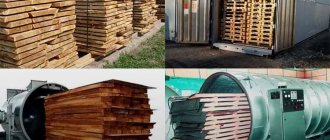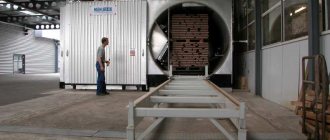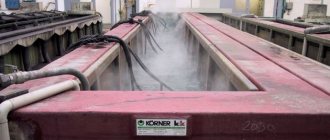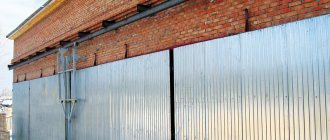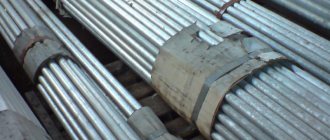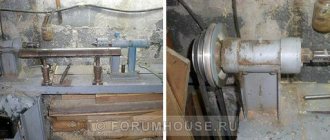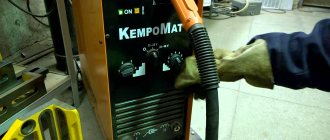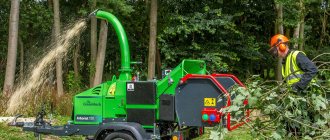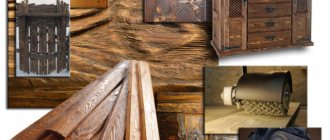In this article:
- Humidity indicators
- Why is proper drying so important?
- Methods for professional drying of wood
Wood is a hygroscopic material that naturally contains moisture and has the ability to absorb it from the atmosphere. Lumber goes on sale in two forms: natural moisture and dried. Of course, the latter are more expensive, so many entrepreneurs, when equipping a sawmill, think about ways to dehydrate the wood.
Humidity indicators
Based on the degree of humidity, the following states of wood are distinguished:
- wet (100% humidity) – logs that have been in water for a long time (for example, transported by rafting);
- freshly cut – humidity depends on the natural growing conditions of the plant, and ranges from 50-100%;
- air-dry - material that is stored in the air (under a canopy) reaches parameters of 12-20%;
- room-dry (8-12%) – drying in a closed, heated and well-ventilated room;
- dry (humidity less than 8%) – prepared by forced moisture release.
You need to know the nuances
Recently, a trend has developed in the forestry industry that investors are investing in production that brings profit in the short term. Because of this, recently they have been trying to build drying chambers in the form of easily and quickly erected insulated metal structures. But here too the question of choice arises. When considering various types of construction (convective, condensation, aerodynamic, vacuum), as a rule, they focus on cost.
Some manufacturers of drying chambers, in an effort to sell their product, do not particularly educate the client, praising their chamber.
Entrepreneurs often order a chamber with a large loading capacity (60-100 m3), mistakenly believing that they will be able to load all the material into it at the same time, including different thicknesses, and in the future it turns out that, having a large chamber, they underload it and violate the technological process.
Why is proper drying so important?
Boards with natural moisture are larger in size than dried ones and are cheaper. This is because lumber manufacturers set tolerances based on future shrinkage and trimming.
Humidity standards:
- for building and carpentry materials – 10-18%. When manufacturing building materials, the production moisture content of wood should be equal to or be 1.25-3.5% lower than the operational moisture content in order to avoid natural drying.
- for furniture production – 8-10%.
The use of lumber with natural moisture is a gross violation of the technological process . When the wood dries naturally, it will change the width, thickness and, accordingly, the geometry of the entire product.
For example, a 50*150mm edged pine board with a natural humidity of more than 50% after a couple of months will have parameters of 48 * 138 mm (for tangential cutting) and 46 * 144 (for radial cutting). Even if we take into account that the length of the product will remain the same (on average, the deviation does not exceed 0.1%), the final difference is catastrophic!
A Question of Choice
Of course, the current state of lumber drying in Russia is not determined solely by the above. When organizing new productions, as well as when modernizing existing ones for the production of competitive high-quality wood products, they try to equip the production with modern equipment, including modern drying chambers. And it is right. However, here it should be noted that when investing in new production, entrepreneurs put the choice of a drying chamber in last place. Caring about technology and purchasing woodworking machines, for some reason they believe that choosing the necessary drying chamber will not be difficult. But this only seems to be a simple matter. There are many nuances that need to be taken into account.
Methods for professional drying of wood
Convective (chamber) drying
The most popular type of drying equipment is convection chambers. About 80% of manufacturers use just such dryers.
Advantages: ease of use, high rate of moisture evaporation, low voltage in the final product, high loading volume (up to 1000 m3).
Supply and exhaust ventilation and heating systems (usually air heaters) are installed in the room. Humidity parameters are measured by a psychrometer and adjusted automatically. Wood waste: wood chips, slabs, sawdust is used as fuel for producing hot water or steam in small production. It is profitable to use electricity and gas only for large volumes of production, otherwise the high consumption and cost of resources will significantly reduce the cost of lumber.
Centrifugal or axial (depending on the configuration) fans ensure uniform distribution of warm air and timely removal of excess moisture to avoid warping, cracking and obtain the highest quality wood in the shortest possible time.
Price – from 160,000 rubles (depending on configuration and cargo capacity).
Atmospheric drying
The natural process of evaporation of moisture from wood, which requires a minimum of investment, but a maximum of time. However, wood dehydrated by atmospheric drying is considered the most resistant to deformation. Most often this happens like this: a tree cut down at the beginning of winter is cut into planks and kept under a canopy until the start of the construction season. In 4-6 months, the lumber has time to dry to 15-20% humidity.
To avoid deformation of the boards during the drying process, the following conditions are necessary:
- stacking on a horizontal flat surface;
- to protect against excess moisture, waterproofing is laid between the rows of stacks and in the area where drying is expected;
- so that the boards are well ventilated, the stack is placed on concrete blocks and laid with timber or unedged boards of the same thickness (see figure below);
- stacks are stacked at equal intervals and parallelism;
- a prerequisite for preventing deformation is a uniform load, which is carried out using wedges or clamping bands (see figure below);
- the finished stack is protected from atmospheric influences, covered with a profile or slate. With this arrangement of the dryer, the edged board will reach 12-18% humidity in 4-5 months. The speed and quality of dehydration depends on the climate, the amount of moisture in the atmosphere and the thickness of the board. The rules for atmospheric drying are regulated by GOST 2808.1-80 for lumber from softwood and GOST 7319-80 for hardwood.
Rice. Air dryer arrangement diagram
Rice. Loading with wedges
Main disadvantages: the structure takes up a lot of space, the drying process is uncontrolled, and in areas with high humidity there is a high risk of lumber being damaged by fungus. For such terrain, it is recommended to pre-treat the boards with an antiseptic.
Vacuum dryer
Used for drying large cross-section wood, deciduous hardwood (for example, oak), valuable wood that is susceptible to cracking. The dryer is a sealed stainless steel chamber into which boards are placed between aluminum heating plates. The top of the chamber is covered with an elastic rubber covering attached to a metal frame.
Hot water continuously circulates across the plates, which is heated by an external boiler. The vacuum inside the chamber is ensured by a pump that pumps moisture out of the room.
Rice. Vacuum chamber operation diagram
A microprocessor is used to control the processes inside the chamber. For each type of wood, the operator sets his own vacuum level and plate heating temperature. For example, a beech board with a thickness of 32 mm reaches 8% humidity in 29 hours. And a pine board with a thickness of 25 mm - in 17 hours. Therefore, the main advantage of vacuum drying is the speed of processing materials .
Disadvantages: small capacity of the chambers (up to 10 m3), high energy consumption, high internal stress due to the uneven distribution of final moisture content throughout the thickness of the material. These shortcomings are eliminated in new vacuum models, where drying is carried out using hot steam.
But the price of such cameras is high: 250,000 rubles for a loading volume of 1 m3.
Microwave dryer
The essence of the “microwave” method: the wood is saturated with moisture, which then evaporates at the level of cellular structures. Dehydration of wood is carried out with high frequency currents - 915-2500 MHz.
The electromagnetic field affects stacked lumber in the space of a metal chamber. Wood is heated at a level of 50-60 degrees, therefore it is considered close to natural conditions.
Main advantages:
- mobility;
- compact dimensions;
- the drying speed is 30% higher than that of convection chambers, with relatively low energy costs (for drying 1 m3 of pine - 550 kW/h, oak - 2000 kW/h).
Flaws:
- small loading volumes (up to 4.5 m3 for hard deciduous trees and up to 7 m3 for coniferous trees);
- the high price of magnetron generators with a fairly short service life (no more than 650 hours);
- uneven drying;
- the possibility of ignition of the material inside the chamber - the microwave method is quite new, and drying modes have not yet been developed.
"A C"
The current state of drying equipment at Russian enterprises can only be described as satisfactory. Sawmills and woodworking industries that have been operating for a long time use a large number of drying chambers of old designs that require significant modernization. And in some cases, cameras are only listed on the balance sheet, but do not work.
In order to properly dry lumber in such conditions, production workers spend enormous amounts of energy and labor. It turns out to be a kind of vicious circle. It is not possible to invest in the re-equipment of drying equipment due to the lack of necessary financial resources. As a result, the company does not have enough resources for effective growth.
Type of heating
Today, a fairly common phenomenon is the desire of most owners of drying kilns and those who are just planning to purchase one to establish heat supply from a hot water boiler that runs on sawmill and woodworking waste. At the same time, many have little idea about the required amount of waste and consider this option to be the cheapest. Maybe in the case of high-power boiler houses of 1-2 MW or more, this is true. Moreover, such boilers are also considered as a wood waste recycler at their enterprise.
In fact, when organizing a small boiler room for autonomous heat supply to the drying chamber, it is more economical to use electric heating or water heating boilers running on gas, diesel fuel and coal. The automatic burner of gas boilers does not require the presence of an operator. In regions with low electricity costs, electric boiler systems are naturally common. Automation of the drying and heat supply process affects the cost reduction, therefore, in the end, it turns out cheaper, or at least is at the level of heating the chamber with woodworking waste.
Different approach
What is important, in my opinion, is the correct choice of drying chamber design, taking into account the performance and quality of drying, and not cost, which is the main criterion today. For example, for a large sawmill producing tens of thousands of cubic meters of materials per year, it is necessary to select chambers with high productivity (drying tunnels, condensation dryers, etc.).
For those entrepreneurs who work with difficult-to-dry hardwood (including exotic) wood, and usually process small volumes, you should pay attention to vacuum dryers, microwave-heated chambers, ultrasonic and the like. With these special methods, it is possible to dry valuable types of wood in blanks efficiently and quickly.
When choosing a specific chamber design, you need to clearly understand what you want to dry and for what purpose.
Are imported ones better?
I cannot agree with the opinion that the prospect for the development of wood drying in Russia lies only in the acquisition of imported drying chambers. The existing stereotype that imported dryers, although much more expensive in cost, allow drying to be of higher quality than domestic ones, is far-fetched and does not have strong and unambiguous evidence. Often, in confirmation of this, not the best example is given with the domestic and foreign automobile industry. Then the question arises: is it even possible to dry qualitatively not in imported dryers? In my opinion, it is possible to dry, if not better, then at exactly the same quality level, in domestic drying chambers.
The main advantages of imported drying chambers are their housing, consisting of aluminum panels, as well as automatic control systems that ensure high-quality drying.
However, the body of the drying chamber made of aluminum can be manufactured with high quality by most domestic enterprises. In addition, Russian manufacturers also complete their designs with imported components (fans, heat exchangers, control systems, etc.). I am confident that domestic companies are quite capable of developing and manufacturing new competitive designs of drying chambers.
In practice, when using imported chambers, problems arise, most often associated with the operation of the automatic drying process system. In most cases, lumber is dried according to factory programs installed in the control unit, and therefore completely rely on automation. Even with a minor malfunction in its operation, personnel are lost, and not everyone knows how to adequately control the camera in manual mode.
Vector for deep processing
The fact that today wood processors are trying in one way or another to organize drying production at their enterprises indicates a desire to engage in deep wood processing, which brings great profit.
An increase in duties on the removal of round timber will lead to an even greater increase in the volume of deep wood processing in Russia. The development of the industry will inevitably affect a significant increase in drying capacity. The prospect for the development of wood drying in Russia as one of the fundamental stages in the production of high-quality wood products, which are used in many industries.
Buy or restore?
Again, returning to the topic of modernization, it should be noted that there is not always a need to buy a new drying chamber, demolish the old one and build a new one. If the condition of the drying chamber enclosing structures is in satisfactory condition, then reconstruction or equipping the dryer with modern equipment is a good option. Of course, if serious restoration is required, then the cost of reconstruction may be the same amount as the construction of a new drying chamber, then reconstruction is not advisable.
Often the need for reconstruction is dictated not only by the wear and tear of equipment or the destruction of fences, but by the task of reducing energy costs and improving the quality of drying or increasing the productivity of the dryer.
